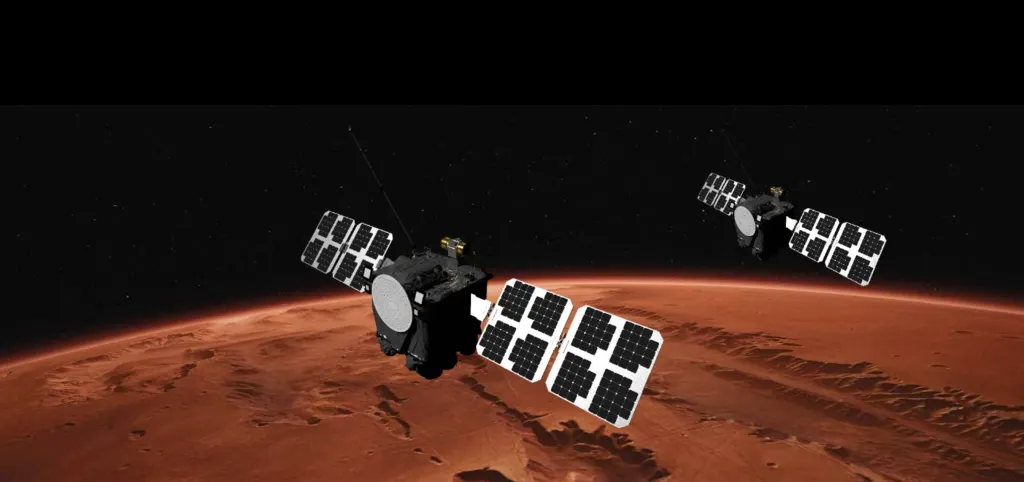Copyright The Mercury News

If you were to stand on the surface of Mars in two years and look up to the night sky, you might see a bright streak flying across the heavens, followed a few minutes later by another. Rather than flecks of space stuff, they would be satellites on a mission led by UC Berkeley scientists. This first-of-its-kind unmanned mission — Escape and Plasma Acceleration and Dynamics Explorers, or ESCAPADE — could launch as early as this Sunday, sending twin satellites to Mars that together will offer the clearest picture yet of the shifting Martian atmosphere and magnetic field. If it succeeds, it could reveal mysteries about how Mars became the red wasteland that we see today, and may help us send humans to safely explore our planetary neighbor. It also pioneers a new path to Mars and a cheaper — if riskier — model for space exploration. “It’s a huge privilege to be leading a mission to Mars,” said Robert Lillis, the UC Berkeley planetary scientist leading the international team of researchers, over email. “(ESCAPADE) will give us a whole new set of ‘eyes’ in understanding how space weather buffets Mars’ atmosphere … It’s hugely significant.” The NASA-funded mission has been nearly a decade in the making, and recruits a team of scientists from around the globe, led by UC Berkeley. After years of planning, the twin satellites could launch in a Blue Origin rocket as early as November 9 from Cape Canaveral, Florida. The satellites will then hang in a loping orbit around the Earth until they use our planet’s gravity to slingshot towards Mars in 2026, hurtling through interplanetary space until they arrive in late 2027. Once they arrive, the twin satellites – named Blue and Gold after UC Berkeley’s school colors – will orbit in formation around Mars, zipping one after the other and taking in reams of measurements about the Red Planet’s atmosphere and magnetic field. While previous satellite missions have taken some similar measurements, none have orchestrated multiple satellites. Having two satellites will give the ability to watch the martian atmosphere over the span of minutes rather than hours, painting a picture of a shifting environment across space and time. With one satellite “you’re really getting a smeared out picture of what’s happening and it’s average in space, and its average in time,” said Gwen Hanley, a science team member for the mission from the UC Berkeley Space Science Lab. “But it doesn’t allow you to do these very small scale, and quickly changing (measurements) that we’re gonna be able to do with ESCAPADE for the first time.” Looking at these could offer insights into fundamental physics — and help us safely put humans on Mars. The sun is constantly buffeting the solar system with radiation and charged particles that wash over Earth and Mars alike. On Earth, humans are protected by our thick atmosphere and strong magnetic field, but Mars has a thin atmosphere and a weak magnetic field, meaning any astronauts navigating the Martian surface could be subject to dangerous radiation. Last year, a solar storm blasted Mars with radiation so strong that a human on the surface would have received the equivalent of 30 chest x-rays worth of radiation in a matter of minutes. Understanding those shifts in radiation may help us protect future humans – and the equipment they carry – from the ravages of solar weather. “There are ways to mitigate against that, but we have to know what we’re facing in the first place. And ESCAPADE is a really big step towards doing that,” said Shannon Curry, ESCAPADE Project Scientist with the University of Colorado Boulder. The solar winds that blast the atmosphere also create a wavering blanket of electrical charge around the planet. Understanding this shifting blanket of electrical charge could be key to knowing how to correct for distortions in radio signals that would be used to navigate the red planet and communicate with and among humans on Mars, helping ensure that we can stay in touch with a crewed mission. The mission may also help uncover mysteries of Mars’ deep past. Billions of years ago, Mars was a warmer place with liquid water that flowed an ancient network of rivers – traits that may have made it hospitable to life – but in order for that to be true, it needed a far thicker atmosphere to blanket it from the cold of space. Now however, the Martian atmosphere has dwindled and the water has mostly frozen. While previous missions have helped us understand that the atmosphere slipped away from Mars, how that happened is still a mystery. The mission hopes to gain insight into this by using the twin satellites to gaze at both the solar winds that buffet the planet and the way the atmosphere reacts at once, offering a cause and effect for what may have slowly stripped away the Martian air. “If we can get the physics right for what’s happening today, we have much better insight into what happened billions of years ago,” said Curry. Beyond the science, the project is pioneering in other ways. ESCAPADE is part of a NASA initiative to fund space exploration projects at a lower cost, while accepting more risk. A martian satellite project launched by NASA in 2013 – called MAVEN – cost some $366 million in development, and has totaled over $600 million in costs over its lifetime, according to the Planetary Society. ESCAPADE cost $49 million to get to the launchpad, a fraction of the cost of its predecessor. While the funding model is meant to give more bang for the buck, the two other projects under this same NASA program failed – one of which lost communication with Earth after being sent to space and the other which was cancelled before launch. Even so, Anna Mittelholz, a planetary scientist at ETH Zürich in Switzerland who is not involved with the project, called ESCAPADE “a remarkable achievement in planetary mission design” for delivering two satellites at a fraction of the cost of other projects. “With such tight budgets, teams are sometimes forced to make compromises that may not be scientifically or technically ideal,” said Mittelholz over email. “That’s not necessarily a flaw. It’s part of a deliberate trade-off to push innovation and efficiency in how we explore other worlds.”



